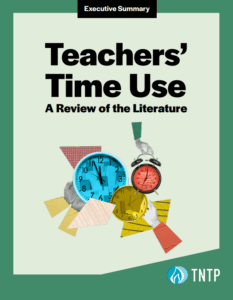Three weeks ago, we released Shortchanged, a new paper on the problems of lockstep teacher pay—namely, that the way 90 percent of school districts currently pay their teachers has nothing to do with how well those teachers actually do their jobs. That’s unfair not only to our best educators, but also to our students and the teaching profession.
We can’t solve this problem without addressing the role played by states. Instead of making things better, they often make them worse.
Forty-three states currently contribute to the problem of lockstep pay. In places like Illinois, South Carolina and several others, state law enshrines lockstep pay by requiring years of experience and academic credentials to trigger pay raises, while restricting the use of performance measures. Many others tacitly allow experience and credentials to be the sole or primary determinants of teacher salaries. At present, just five states require that measures of effectiveness serve as the primary criteria for teacher pay.
But we think states can also help fix the problem. With states providing the majority of funding to public schools—about 83 cents of every dollar spent—there is an important and appropriate role for states around teacher pay. There are clear steps states should take to ensure smart compensation systems that support great teaching and to support districts as they design and implement new systems that meet their local needs. In a handful of states like Florida and Nevada, policy leaders have already moved in this direction, and they offer different versions of what statewide compensation reform can look like.
Today, we’re releasing a guide that focuses specifically on how state leaders can remove barriers to creating smarter teacher compensation systems at the local level.
Here’s what we think state legislators should be considering in 2015:
Look at current state laws and regulations governing teacher pay and consider crafting bills that set minimum guidelines for compensation systems that incorporate measures of performance. We know these aren’t quick fixes, and controversial changes like these will likely need to be phased in, but setting a state-level precedent for compensation systems that value great teaching is critically important. State leaders should aim for policies that phase out mandated automatic salary increases not based on performance; reduce or remove mandated salary increases based on advanced degrees; increase compensation for early-career high performers; and make performance (e.g., as demonstrated through a multiple measure evaluation system) a significant factor in salary increases at all experience levels.
Encourage districts to go beyond the minimum. Minimum standards are a good start, but they leave open the possibility for local pay structures that just barely meet the criteria—including measures of effectiveness as a tiny percentage of the salary calculation, for example—and don’t do much more. State leaders can look for ways to offer incentives or support for district programs that recruit and reward teachers in high-need subjects and schools, and create career pathways that will expand the reach of highly effective teachers as mentors and teacher leaders.
Offer the resources districts need to make smarter compensation work. States should offer model compensation systems that districts can either adopt off-the-shelf or customize for their own needs. Other useful resources state education departments can provide include salary calculators to help teachers visualize what will happen to their earnings as a result of performance-based compensation; communications plans to help districts roll their new systems out to the public; and analytical support to help districts ensure that new compensation systems are built on valid data about teacher performance.
No single policy change is going to solve all of the challenges school leaders and teachers are working every day to overcome. But policies that drive smarter teacher compensation systems need to be on state leaders’ to-do lists, as part of a comprehensive commitment that aligns with other efforts to recruit and retain the best teachers and elevate the teaching profession.
Some states are taking steps to modernize their approach to licensing teachers, by focusing on teacher performance rather than an archaic system of inputs, and providing greater local autonomy to hire teachers that meet each district’s needs. Aligned changes to compensation would allow districts to pay great teachers more, earlier in their careers and to make the profession more attractive to top-performing college graduates or career changers. By reducing barriers to entry through licensure and providing districts with more discretion to pay teachers for what really matters, for example, professional scientists could be licensed to teach high school physics or biology, and earn more for the work experience and academic credentials that are meaningfully connected to student outcomes—while high-performing new teachers with only bachelor’s degrees could climb the salary ladder more quickly based on their performance in the classroom.
Ultimately, of course, policy can only go so far, and it’s up to district leaders to see the work through to action. But if we’re going to build a national movement toward paying great teachers what they’re really worth—and paying for what really matters in the teaching profession—it’s going to take both policy work at the state level and implementation work at the local level to make it happen.








